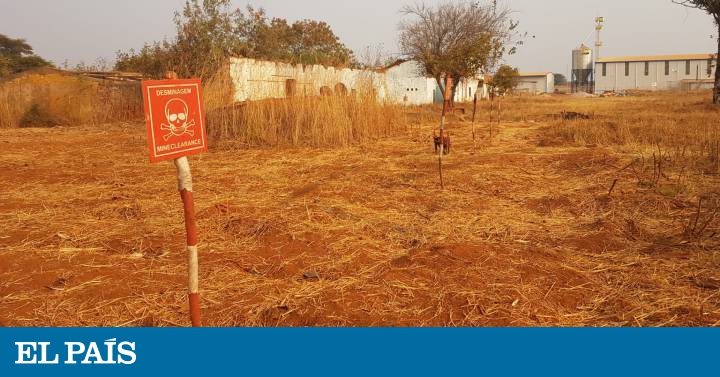Angela Hoyos and her companions sit next to a small group of people ready to open up about some of the most painful experiences of their lives. Little by little and with very specific questions, they will be asked to look back and forward. Let them tell how your reality changes when you live under the threat that one false step could be the last. Or what it's like to start a new chapter when the mines that once surrounded you are transformed into onions and tomatoes.
MORE INFORMATION
- KiandaHub: The space that Luanda needed
- The hell of an unfinished war
- Uganda has an outstanding account with antipersonnel mines
The Spanish researcher works at the International Center for Humanitarian Demining in Geneva (GICHD). The team of which she is a part spent several weeks touring Huambo and Kuando Kubango, two regions of Angola, a country that practically knew no state other than that of war since 1961. First the independence of Portugal (until 1975) and then a civil conflict that ended in 2002 and represents the longest confrontation in the entire continent. The objective was, broadly explained, to study how action against mines changes people's lives in the medium and long term socially and economically. In the last 20 years, the percentage of the population living in poverty has gone from 68 to 37%.
"They told us: 'This is a second war for us," explains Hoyos. The peace treaties may have been signed, but the presence of explosives persists in many areas of the country. "All parties used the mines, they were used in accordance with different military tactics and doctrines, which led to a complexity of devices that have not been seen in many other places. They were located on roads and bridges, to protect key strategic infrastructure, to ambush enemy forces, as a deterrent or even to instill terror through random placement patterns, "details the study they developed from the experience.
The purpose of this project was to go beyond the mapping of safe areas, they wanted to know what it meant in the day to day of thousands of people. Nothing better for that than sitting down to talk long hours with neighbors from different villages. The Halo Trust organization, which has spent years cleaning explosives in the country, had previously contacted them to ask for their participation. "This was a very necessary step so that they understood what we were doing there and it was not strange for them that we suddenly presented ourselves to ask them questions," Hoyos said on the phone. "We had to go from the general to the particular, and put things very concretely, you couldn't sit there and say: 'Well, tell me how the presence of mines has affected you.'
The structure was almost always the same. First the sobas , or community leaders, made their views known . The rest of the men accompanied them. They told them how the cleaning of explosives had allowed them to have access to electricity or water, that they could undertake in sectors in which they would not have imagined before or how the railway service was reestablished. Hours later, they managed to reach the testimonies of the women. "They spoke of deliveries in better conditions and in general of health issues that the men had not paid attention to. They also related how children could now study at least until high school," Hoyos summarizes.
From 1975 to 2002, around one and a half million Angolans died. Another four million were internally displaced and more than half a million sought refuge in neighboring countries. Halo Trust says they have deactivated more than 100,000 artifacts, but it is impossible to know how many are still on the ground.
During all that time, the locals built a whole way of life conditioned by the possibility of dying from a bad step. The research describes, for example, how the inhabitants of Samaria, a village that experienced one of the bloodiest battles in 1987, devised routes that avoided contaminated areas. These practices are still maintained today, because they continue to use SUVs that they know as "taxis" to visit their relatives in fenced municipalities still surrounded by mines. "Sometimes, the population accumulates explosive residues in their homes thinking that they are going to get some profit and there end up being problems," says the researcher.
In the case of Angola, the placement of artifacts even reached fields intended for agricultural use, which had a tremendous impact on the quality of food. It was through these fields that Princess Diana walked in 1997, and through which years later her son Enrique walked. Before demining, most crops were restricted to pumpkins, potatoes, cassava, or walnuts. With the cleanup, the markets and houses began to fill with rice and, most importantly, vegetables such as onions, tomatoes, or beans. They went hunting and beekeeping again, so they now have honey. "They had access to more seeds, and the exchange of fruits and vegetables was streamlined," says Hoyos. However, the ease of communication with the cities also resulted in the diet being filled with not always healthy products such as salt and sugar.
Huambo, one of the studied regions, was once an important trade center, many localities depended on these communications. Until 2012, its train service was not repaired and little by little it resurfaced. Today, rail transport in the area carries more than 2,300 passengers a day, and supplies again reach many consumers.
Many of the travelers in these wagons head today to see family and friends. The train cut and the insecurity of the roads made it impossible to visit someone in another town. A social distancing that now costs very little to understand, but that at that time was not caused by a virus, but by a war that seemed eternal.
You can follow PLANETA FUTURO on Twitter and Facebook and Instagram, and subscribe here to our newsletter.






/cloudfront-eu-central-1.images.arcpublishing.com/prisa/2C5HI6YHNFHDLJSBNWHOIAS2AE.jpeg)




